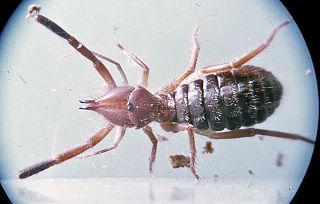
Reginald Innes Pocock, was a British zoologist.

Ammotrechidae is a family of solifuges distributed in the Americas and the Caribbean Islands. It includes 26 described genera and 95 species. Members of this family can be distinguished from members of other families by the absence of claws on tarsi of leg I, tarsal segmentation 1-2-2-(2-4), pedipalps with pairs of lateroventral spines, and by males having an immovable flagellum on the mesal face of each chelicerum. The propeltidium of the Ammotrechidae is recurved.

Daesiidae is a family of solifugids, which are widespread in Africa and the Middle East. Members of the family are also present in India, Italy, South America, the Balkans, and the single species Gluvia dorsalis in the Iberian Peninsula. A single fossil species is known from Eocene Baltic amber.

Zeria is a genus of solpugid camel spiders, first described by Eugène Simon in 1879.

Solpugidae is a family of solifuges or sun spiders. Solpugidae have groups of papillae on their pedipalps or sensory organs. The papillae come out of sockets that are characterized with the function of mechanoreceptor, and contact chemoreceptors, which allows them to respond to stimuli such as touch and sound.

Hexisopodidae is a family of solifuges, first described by Reginald Innes Pocock in 1897.
Ceromidae is a family of solifuges, first described by Carl Friedrich Roewer in 1933.
Pseudocleobis is a genus of ammotrechid camel spiders, first described by Reginald Innes Pocock in 1900.
Ceroma is a genus of ceromid camel spiders, first described by Ferdinand Karsch in 1885.
Ceromella is a genus of ceromid camel spiders, first described by Carl Friedrich Roewer in 1933.
Biton is a genus of daesiid camel spiders, first described by Ferdinand Karsch in 1880.

Blossia is a genus of daesiid camel spiders, first described by Eugène Simon in 1880.
Gluviopsis is a genus of daesiid camel spiders, first described by Karl Kraepelin in 1899.
Gylippidae is a family of solifuges, first described by Carl Friedrich Roewer in 1933.
Melanoblossiidae is a family of solifuges, first described by Carl Friedrich Roewer in 1933.
Rhagoderma is a genus of rhagodid camel spiders, first described by Carl Friedrich Roewer in 1933.
Rhagodes is a genus of rhagodid camel spiders, first described by Reginald Innes Pocock in 1897.
Rhagodoca is a genus of rhagodid camel spiders, first described by Carl Friedrich Roewer in 1933.
Zeriassa is a genus of solpugid camel spiders, first described by Reginald Innes Pocock in 1897.
Solpugyla is a genus of solpugid camel spiders, first described by Carl Friedrich Roewer in 1933.







